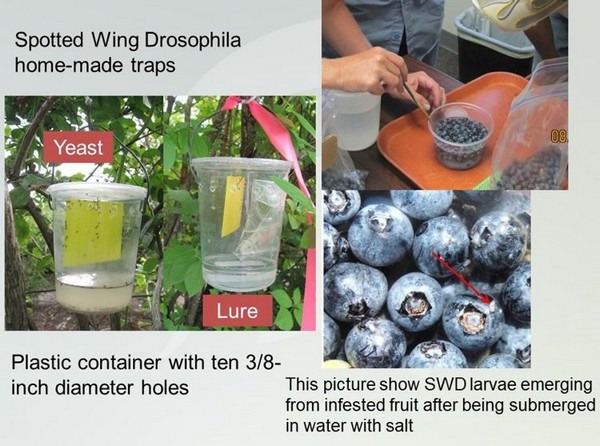Michigan had a mild winter and is experiencing a warm summer, resulting in early activity of a few insect pests as the peak of blueberry harvest approaches. Michigan State University is seeing increases in blueberry maggot and spotted wing drosophila catches at various monitoring sites in southwest Michigan in the past week. Growers with ripening and ripe blueberries should be protecting those fields using effective insecticides.
 Figure 1. This picture shows spotted wing drosophila (SWD) monitoring traps with yeast and commercial lure. It also shows the sampling method to detect SWD larvae submerging the fruit in salty water for 15 minutes. Photo by Carlos García-Salazar, MSU Extension.
Figure 1. This picture shows spotted wing drosophila (SWD) monitoring traps with yeast and commercial lure. It also shows the sampling method to detect SWD larvae submerging the fruit in salty water for 15 minutes. Photo by Carlos García-Salazar, MSU Extension.
There are various options registered for these pests, with high efficacy and short preharvest intervals that can be used during harvest season. See the Michigan State University Extension bulletin E154, "Michigan Fruit Management Guide," for recommendations. This publication is available in hard copy and as a downloadable PDF.
For timing your insecticide applications against spotted wing drosophila, place monitoring traps with a bait made of brewer's yeast or a commercial lure in fields as shown in Figure 1.
Blueberry maggot can be managed using applications every 10 to 14 days, but protection against spotted wing drosophila requires a tighter spray interval. You can also monitor berry infestation levels by taking weekly fruit samples focused on fields approaching harvest to check that they remain free of insects. Michigan State University has developed a short, 8-minute video explaining this method and providing guidance on the simple equipment needed.
Source: canr.msu.edu
